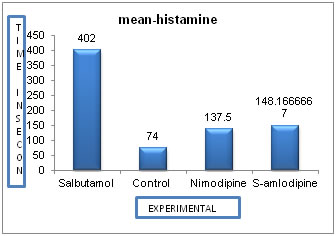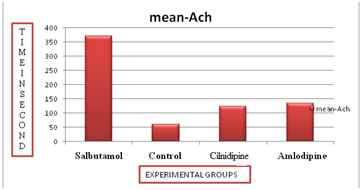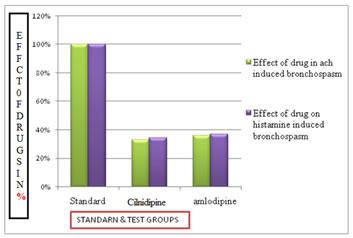Official Journals By StatPerson Publication
|
Table of Content Volume 4 Issue 1 - October 2017
A Study to compare antiasthmatic activity of Cilnidipine and Amlodipine with Salbutamol
M D Sibgatullah1, Shruthi S L2*
1Drug Safety Physician, Vigi Medsafe Pvt Ltd, Hyderabad, Telangana, INDIA. 2Tutor, Department of Pharmacology, Shimoga Institute of Medical Sciences, Shimoga, Karnataka, INDIA. Email: drshruthideepak@yahoo.com
Abstract Background: Cilinidipine can act on the N-type calcium-channel that existing sympathetic nerve end besides acting on L-type calcium-channel that similar to most of the calcium antagonists. Due to its N-type calcium-channel blocking properties, it has more advantages compared to conventional calcium-channel blockers. It has lower incidence of Pedal edema, one of the major adverse effects of other calcium channel blockers Methodology: Guinea pigs were divided in to four groups with six animals in each. They were treated with respective drugs for a period of 5 days. On 4th day they were housed in aerosol chamber for acclimatization. On 5th day, 2 hours after drug administration each guinea pig was exposed to aerosols of histamine in the histamine chamber. PCD time was noted. Just before onset of convulsion animals were shifted to fresh air and allowed to recover. The subsequent week same process of drug administration was followed. Results: The test groups also showed a significant and increase in the mean PCD time when compared to control group of animals. Cilnidipine had an increase of about 73.1seconds and 73.33 seconds in histamine induced bronchoconstriction method and acetylcholine induced bronchoconstriction method respectively. Amlodipine had an increase of about 58.5 seconds and 63 seconds in histamine induced bronchoconstriction method and acetylcholine induced bronchoconstriction method respectively. Conclusion: They will be of significant value in patients who are hypertensive and also asthmatics. Key Words: Cilnidipine, Amlodipine, Salbutamol.
As of 2011, 235–330 million people worldwide are affected by asthma,1,2 and approximately 250,000–345,000 people die per year from the disease. Rates vary between countries with prevalence’s between 1 and 18%. It is more common in developed than developing countries. One thus sees lower rates in Asia, Eastern Europe and Africa3. Within developed countries it is more common in those who are economically disadvantaged while in contrast in developing countries it is more common in the affluent. The reason for these differences is not well known. Low and middle income countries make up more than 80% of the mortality3. While asthma is twice as common in boys as girls, severe asthma occurs at equal rates2. In contrast adult women have a higher rate of asthma than men and it is more common in the young than the old. In children, asthma was the most common reason for admission to the hospital following an emergency department visit in the US in 20114. Global rates of asthma have increased significantly between the 1960s and 2008 with it being recognized as a major public health problem since the 1970s3. Rates of asthma have plateaued in the developed world since the mid-1990s with recent increases primarily in the developing world. Asthma affects approximately 7% of the population of the United States and 5% of people in India46.Canada, Australia and New Zealand have rates of about 14–15%4. Many environmental factors have been associated with asthma's development and exacerbation including allergens, air pollution, and other environmental chemicals. Smoking during pregnancy and after delivery is associated with a greater risk of asthma-like symptoms. Low air quality from factors such as traffic pollution or high ozone levels has been associated with both asthma development and increased asthma severity. Exposure to indoor volatile organic compounds may be a trigger for asthma; formaldehyde exposure, for example, has a positive association. Also, phthalates in certain types of PVC are associated with asthma in children and adults. There is an association between acetaminophen (paracetamol) use and asthma. The majority of the evidence does not; however, support a causal role. Use by a mother during pregnancy is also associated with an increased risk5. Asthma is associated with exposure to indoor allergens. Common indoor allergens include: dust mites, cockroaches, animal dander, and mold. Air pollution, cold air, and exercise in cold air, perfumes, air fresheners, dusty rooms and other scented products6. Calcium channel antagonists cause generalized arterial/arteriolar dilatation, thereby reducing blood pressure, but do not much effect the veins. They affect all vascular beds, although regional effects vary considerably between different drugs. They cause coronary vasodilatation, and are used in patients with coronary artery spasm. Other types of smooth muscles are also relaxed by calcium channel antagonist 7. Amlodipine pharmacokinetically is a dihyropyridine calcium channel antagonist that has a slow absorption and a prolonged effect. With a plasma t1/2 of 35-50 hours, plasma levels and effect increase over a period of 7-10 days of daily administration of a constant dose. Amlodipine produces both peripheral arterial vasodilatation and coronary dilation, with a hemodynamic profile similar to that of nifedipine8.Compared with other calcium antagonists, cilinidipine can act on the N-type calcium-channel that existing sympathetic nerve end besides acting on L-type calcium-channel that similar to most of the calcium antagonists. Due to its N-type calcium-channel blocking properties, it has more advantages compared to conventional calcium-channel blockers. It has lower incidence of Pedal edema, one of the major adverse effects of other calcium channel blockers. Cilnidipine has similar blood pressure lowering efficacy as compared to amlodipine. One of the distinct property of cilnidipine from amlodipine is that it does not cause reflex tachycardia9.Nifedipine, a calcium channel blocker has earlier been successfully experimented in guinea pigs for broncho dilatation effect. It has now been recognized that asthma is characterized by a persistent ongoing airway sub mucosal inflammatory process which may underline bronchial hyper-responsiveness and airway obstruction. However, recent work raised doubts about existence of intrinsic or non-allergic asthma. It has been postulated that all asthma is IgE mediated. Even in non-atopic subjects, an early asthmatic reaction can be induced by exposure to allergen which causes the helper T cells to stimulate B lymphocytes through IL4 resulting in increased IgE production and degranulation of mast cells. Calcium ions are closely involved in excitation contraction of smooth muscle and also in secretory process including the release of mast cell inhibitors. Bronchial smooth muscle contracts when concentration of free cytosolic calcium ions increases due to cell membrane depolarization, however, one of the defects in asthmatics is an altered control of calcium influx. Nifedipine is a potent inhibitor of trans membrane calcium influx. Studies in animals have shown that although it does not cause any relaxation on resting membrane level, in dogs, it inhibited contractile response of prostaglandin and histamine and citric acid, meth choline and antigen induced bronchoconstriction in vivo resulting in relaxation of tracheobronchial tree of guinea pig, where bronchoconstriction was, induced by histamine and carbachol without altering the testing tone. However, Jindal et al10 did not find protective effect of nifedipine on methacholine induced bronchoconstriction in asymptomatic male smokers. It is possible that cholinergic induced bronchoconstriction depends mainly on intracellular calcium while nifedipine mainly inhibits extracellular voltage dependent channels Inhibitory action of nifedipine on bronchoconstriction of inhaled histamine has also been Reported. MATERIAL AND METHODS Guinea pigs were divided in to four groups with six animals in each. They were treated with respective drugs for a period of 5 days. On 4th day they were housed in aerosol chamber for acclimatization. On 5th day, 2 hours after drug administration each guinea pig was exposed to aerosols of histamine in the histamine chamber. PCD time was noted. Just before onset of convulsion animals were shifted to fresh air and allowed to recover. The subsequent week same process of drug administration was followed. But on 5th day instead of histamine aerosols, acetyl choline aerosol spray was used and PCD time was noted. Effect of the drugs was compared with control, standard and each other based on PCD time. Greater the PCD time more is the bronchial smooth muscle relaxant effect. Material Required
Chemicals
Drugs required Normal saline Salbutamol Amlodipine Cilnidipine Procedure: Before starting the study permission from animal ethical committee of JSS Institute of Medical Science, Mysore was taken.
RESULTS Table 1: Increase in mean PCD time in different groups when compared to control group
Figure 1: Diagrammatic representation of mean PCD time of various groups in comparison to each other by acetylcholine induced bronchospasm model Figure 2: Diagrammatic representation of mean PCD time of various groups in comparison to each other by histamine induced bronchospasm mode
Table 2: Comparison of PCD time between means of test drugs with means of standard drug, considering standard to 100%
Figure 3: Diagrammatic representation of PCD time between means of test drugs with means of standard drug, considering standard as 100% DISCUSSION The standard drug has the maximum bronchial smooth muscle relaxant activity with a mean increase in the PCD time at 328 seconds in histamine induced bronchial constriction method and 311 seconds in acetyl choline induced bronchial constriction method. The test groups also showed a significant ant increase in the mean PCD time when compared to control group of animals. Cilnidipine had an increase of about 73.1seconds and 73.33 seconds in histamine induced bronchoconstriction method and acetylcholine induced bronchoconstriction method respectively. Amlodipine had an increase of about 58.5 seconds and 63 seconds in histamine induced bronchoconstriction method and acetylcholine induced bronchoconstriction method respectively. Cilnidipine and amlodipine having 33.1% and 36.06% effect in ach induced Broncho constriction respectively. And in histamine induced bronco constriction cilnidipineandamlodipine having 34.20% sand 36.86% effect respectively. There is statistically insignificant difference between the test drugs in both the models signifying similar effectiveness with each other. Our test drugs have shown a significant bronchial smooth muscle relaxant activity indicated by a significant rise in the PCD time when compared to the control group. Calcium channel antagonists cause generalized arterial/arteriolar dilatation, thereby reducing blood pressure. They affect all vascular beds, although regional effects vary considerably between different drugs. Other types of smooth muscles are also relaxed by calcium channel antagonist. Calcium ions are closely involved in excitation-contraction of smooth muscles and also in secretory process including the release of mast cell inhibitors. Bronchial smooth muscle contracts when concentration of free cytosolic calcium ions increases due to cell membrane depolarization. However, one of the defects in asthmatics is an altered control of calcium influx. Also the calcium channel blockers have got an anti-inflammatory activity because they tend to inhibit the release of mediators of inflammation. Bronchial constriction and airway inflammation are both hall marks of asthma. The test drugs showed a significant result when compared to the control group but a minimal effect when compared to the standard drug i.e. salbutamol. This may be due to their propensity towards vascular smooth muscles rather than smooth muscles found elsewhere in the body. The currently used drugs for the treatment of asthma in modern medicine are far from satisfactory as they provide only symptomatic relief, produce several adverse effects and may lose effectiveness on continued used. Muscle tremor and hypokalemia are major adverse effects of beta2 agonists. Theophylline has narrow therapeutic index and requires therapeutic drug monitoring. Adverse effects of corticosteroids includes fluid retention, increased cell mass, increase appetite, weight gain, osteoporosis, capillary fragility, hypertension, peptic ulceration, diabetes, cataract, psychosis, etc.11,12 The use of calcium channel blockers as an add on therapy to the current crop of anti-asthmatics will be a welcome addition in view of above mentioned draw backs of current drugs. Moreover they can be used as drugs of choice in patients who are hypertensive as well as asthmatics.
CONCLUSION
REFERENCES |
|
 Home
Home



